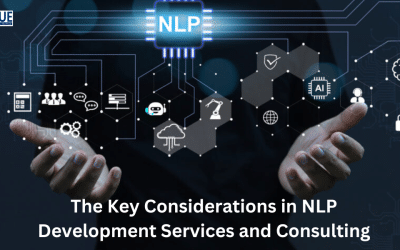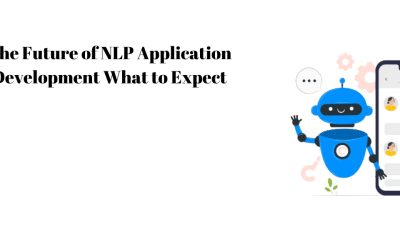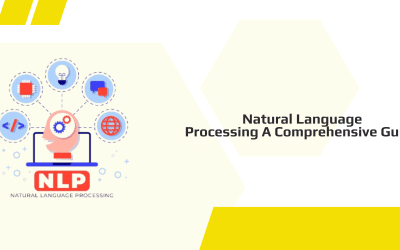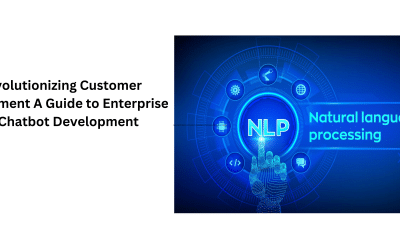AI is a topic that everyone is thinking about at this moment, and it’s not only because it’s entertaining trying out different prompts and observing what ChatGPT and Bard respond to. In particular, most people in sales, marketing, and customer service are witnessing an increase in chatbots daily. Currently, 63% of all retailers employ artificial intelligence to provide superior customer service. However, they aren’t all able to create these solutions independently. Companies may have difficulty establishing one customer support center or offering this service with the help of a few experts.
There are many possibilities for using Artificial Intelligence (AI) to enhance the tasks support staff perform and ultimately impact customer service. In contrast, the technology can communicate, write, assist with diagnosing, and generate original information, so it’s easy to be a little nervous.
In this article, we’ll examine conversational AI as a field of AI technology that significantly impacts the customer experience. This article will explain what it is, how it operates, and how it could be utilized as an element of your support plan and answer that crucial query.
What Is Conversational AI For Customer Service?
A conversational AI used for customer support leverages the natural process of speech (NLP) and machine learning (ML) to interact with customers in a natural method using chatbots or virtual assistants. It is designed to comprehend the user’s needs and questions written in human languages via voice or text input. It will then provide appropriate and appropriate answers.
Conversational AI customer support systems generally run on algorithmic learning, which is trained using vast amounts of information, including chat transcripts of previous conversations, knowledge databases, and other relevant data. This type of training enables AI technology to recognize the purpose and meaning of the client’s query and offer the appropriate response.
AI software for customer service can be used across different platforms, including mobile apps, website message platforms, and voice assistants. In this way, AI technology can provide customers with a continuous and seamless experience regardless of the communication channel used. Conversational customer experiences can help companies reduce waiting times and boost user satisfaction. They can even reduce the operational expenses associated with traditional customer support techniques. Conversational AI can be found in many customer contact points, primarily focused on improving self-service interactions.
How Does Conversational AI Function In Customer Support?
Conversational AI For Customer Service utilizes a range of methods and technologies:
- Natural Language Processing (NLP) is a set of algorithms that analyze and comprehend the user’s input, be it in spoken or written form
- Natural Language Understanding (NLU) builds on NLP to help you understand the client’s intent, emotions, and spoken language nuance.
- The machine learning (ML) model recognizes patterns and relations in the data it receives, which allows it to create appropriate and pertinent responses.
- Dialog Management determines an appropriate decision or response by considering the current context of a conversation and AI’s interpretation of customer input.
- Response Generation: after the system has read the user’s input and figured out the correct response, it creates an output in natural language.
The combination of these tools and strategies creates conversational AI for customer service. It recognizes questions, offers pertinent and customized responses, and completes tasks or transactions using natural language interaction.
Benefits Of Implementing AI In Customer Support
While conversational AI might not be ready to manage every interaction with customers, it’s still an effective device that can boost the service your staff provides and the customer experience you get.
There are many benefits to using chat-based AI tools in your support strategies for customers:
24/7 Availability
One of conversational AI’s main advantages is its capacity to respond to customers’ queries throughout the day and all night. The constant availability of chatbots will change the game in industries, and quick response is crucial in keeping customers satisfied. To reduce waiting times, chatbots powered by AI and virtual agents can ensure that customers’ needs are addressed quickly, no matter the duration of the call.
This function is crucial to businesses that deal with customers across different time zones. This feature improves the customer’s engagement and aids the customer service team in handling the multitude of common questions, allowing them to address the more complicated questions.
Multilingual Support
Conversational AI’s communication capability in different languages expands the company’s coverage. Chatbots can communicate with clients in multiple languages, making it more straightforward for people.
This is especially beneficial in areas home to different populations. It helps to ensure customer satisfaction. Eliminating communication barriers that can make customer interaction challenging enhances the customer experience overall. It also allows access to previously tricky markets due to language difficulties.
Automatization Of Routine Chores
Automatization is another significant benefit. Conversational AI makes it simpler for customers to handle a variety of services, from questions to structured transactions such as making payments or scheduling meetings. It lets the human staff in contact centers focus on dealing with complex problems that require individual contact. Additionally, this degree of automation can result in significant cost savings by optimizing resources and decreasing the necessity for a large workforce during peak or off times.
Improved Customer Engagement
Conversational AI is essential to improving the customer experience by providing regular, personal interactions via apps and social networks. By analyzing customer information and previous interactions, AI systems can provide individual product suggestions and tailored recommendations.
This method of proactive thinking increases customer experience and the chance of generating additional sales and repeated business. Utilizing conversational AI across various platforms or adopting an omnichannel strategy guarantees the customer a smooth experience regardless of the channel used.
Scalability
Scalability could be among the main benefits of AI-based conversation. When businesses expand in size, the amount of questions can grow significantly. AI-based systems can handle increased inquiries without requiring more personnel to assist. The scalability of AI systems ensures that the quality of service remains consistent as customer numbers and demands for assistance grow. This is true whether via a simple messaging interface or a sophisticated CRM system. Conversational AI can respond to changes in demand without degrading the quality of service.
Allows For Room To Grow
Although many support team members are worried about losing their jobs to AI, it can create space for more exciting tasks, enhancing abilities, and making strides toward individual career goals.
Data-Driven Insights
Conversational AI systems can record and study customers’ interactions. They can provide helpful analytics based on data about user behavior, preferences, and the causes of problems. These insights can be leveraged to develop products and services to optimize products and elevate overall shopping customer experiences.
Conversational AI is a great option for customer support. It offers many advantages, making it desirable for companies looking to improve their customer support.
What Would Conversational AI Be Like For Customer Support?
Conversational AI can be found when dealing with customers at a variety of locations but is mainly used in self-service environments such as:
Chatbots And Virtual Agents Chatbots Powered By AI
Often known as chatbots, sometimes referred to as virtual agents, they deliver the most enhanced CX than their counterparts using rules. When users have hit a wall as their interactions diverged from what was expected to be an assistance flow, chatbots powered by AI can better manage unexpected events and deliver more reliable, human-like answers.
Interactive Voice Response (IVR) Systems
Although traditional IVR systems are built on rules, they may struggle to recognize spoken language in cases of problems caused by accents, slang, or even a poor phone signal; conversation IVR systems are based heavily on ASR, NLP, NLU, and ML for better customer support.
Knowledge Base
Even with a good design and the most reliable search engine, it still needs to be easier for consumers to locate the data they’re searching for within a knowledge base. If a knowledge base has been equipped with AI that can be spoken to, users can find the correct resource quickly by simply asking the base for a query in simple language and getting it to “understand” and respond.
Steps Of Implementing Conversational AI For Customer Service
Businesses require assistance in completing the AI integration procedure. Therefore, the software engineers of developer firms usually take on the task. We’ve decided to discuss the various stages of this procedure to help businesses become aware of the processes.
Finding The Necessary Data
Conversation tools require lots of precise information to function effectively. These data sources include texts or numbers, pictures, and even videos. Solutions for business-related use require access to past conversations or transactions and feedback. Researchers need to locate this data and then prepare it for use.
The information is available in structured, semi-structured, and non-structured. The first type of data comes from documents like customer satisfaction and analytics, which allow conversational tools to make better decisions. The unstructured data comes from open-ended responses. In addition, semi-structured information is found in CRM emails.
Structuring And Labeling The Information
The developers then have to organize and precise data with specially designed tools. The data used by the conversational AI contact center software should be classified based on specific categories such as the product’s name, purchase history, and demographics. Properly implementing AI assistants and their precise learning requires high-quality information and an absence of contradictions.
Creating Support-Specific Intents
Making support-based intentions in AI to assist customers is a complex process. This requires a detailed analysis to find recurring problems and frequent themes. Developers should create distinct intents on the main subjects that coincide with the customer’s journey.
Training The AI Model With Gathered Data
Then, the programmers train the model using structured data. They begin by developing engineering features and determining the dataset’s pertinent features. They must be in line with needed outcomes for customer service. In the second place, they split the data into training and validation sets.
Most of it is used as training data, which aids the AI model in understanding the complicated connections and patterns in the information. The third step is to select an appropriate AI design responsive to the specific requirements of customer support tasks. They also use the human hand to examine the learning process.
Integrating The Model With The Workflows
Once the model has been trained with an AI model, the engineers integrate it with the existing customer service workflows. Data management systems will ensure a seamless process when organizing and processing customer requests.
Experts should consider solutions like live chatbots for quick and precise customer service. By relying on AI-generated information, an automated decision-making process can be incorporated into the customer service process, making it more reliable.
Testing And Updating The Solution
In the last integration stage and after release, the developers evaluate artificial intelligence applications from two perspectives: customers and agents. First, the testers conduct usability checks for features such as question handling and access to data. This test helps to determine ease of use and uncover any issues.
In the next instance, tests will determine how AI tools deal with conversations and the quality of their replies. In this manner, specialists gather feedback on the AI software, which assists in finding bugs that need enhancement.
Common Mistakes Associated With Conversational AI Implementation
At first glance, SaaS Customer Service Conversational AI integration into customer support systems appears simple. Companies can invest time and money but not see the desired results. Several fundamental errors make this method useless in various implementation stages.
Lack Of Coherent Strategy
The biggest error businesses often make is the inability to develop a well-thought-out development plan. The best approach is to be focused on a specific purpose that meets specific user demands. It is possible to achieve this by first studying their behavior. The outcomes of this study will affect the nature of the data used, its application, and the tone of the communication software.
Not Finding The Right Use Case
Correctly applying a chat product could be beneficial over the long term. However, if this occurs, the company cannot achieve its business goals or interests. Conversational applications must be designed to meet users’ and employees’ expectations.
Failing To Identify The Main Goal
The most disastrous thing firms can do is create an AI device with a specific goal to achieve. This results in tools that cannot provide pertinent data or understand user demands, which means they don’t meet business demands or improve user experience.
Breaking Conversational Rules
A different common issue occurs if conversational rules are not followed. Conversational rules determine the character of conversations and AI devices. Suppose chatbots are designed to deliver robotic and sterile answers or communicate with customers incorrectly. In that case, it can affect customer experience and product interactions.
Launching Without Appropriate Tests
Lack of thorough testing is among the main factors behind unsuccessful conversations in AI projects. They lack the proper scaling capability to keep up with corporations. Sometimes, the result is problems or even unusable programs. The worst part is that businesses must begin the process again to find out where they have gone wrong.
Best Practices To Implement Conversational AI In Customer Service
Using a chat-based AI platform to provide customer service isn’t something you can do with a simple set-it-and-forget-it type of. You must have an organized process, a solid understanding of what you need, and a constant check of the platform.
Here are some best practices for successfully integrating conversational AI into customer service processes:
Define Clear Goals
Establishing the precise requirements and reasons for implementing Conversational AI Customer Service is essential. It could be decreasing response time, handling simple inquiries, enhancing self-service functions, or improving customer service overall. Setting clear objectives will allow you to guide your implementation and track progress.
Put Your Money Into Quality Education
The efficiency of conversational AI dramatically depends on the high-quality learning data it provides. Ensure you create the AI with various customer interactions, such as responses, queries, and contextual information. Keep updating and improving the data used to train it to increase the accuracy of your AI and its understanding as time passes.
Customizability
A conversational AI service provider should offer solutions suited to specific company needs. Businesses that require customized tools must avoid tools that are available in the box and concentrate on customized development solutions. Tools developed by AI engineers provide a distinctive client experience because they’re customized to fit the brand’s branding.
Detailed Reports
The business needs a method to evaluate the effectiveness of the integrated AI tools. The only way to do this is by accessing usage metrics and performance evaluations. Therefore, the providers need to provide analytic tools that can be used to determine the degree to which users are drawn to and satisfied with these chat tools.
Mix Conversational AI With Human Agents
Chatbots can efficiently manage a wide range of customers’ service requests, but it’s essential to strike the perfect balance between AI capabilities and human support staff. An adequately designed customer support strategy will draw on the strengths of AI and human assistance.
AI agents are great at handling regular, large-volume queries with speedy responses and even offering self-service services. However, human agents are valuable for more complicated or delicate issues that demand compassion, emotional intelligence, or a sense of subjectivity.
Prioritize Integrations And Delivery Via Omnichannel Channels
Conversational AI tools must connect seamlessly to existing customer service channels and backend systems. The integration enables the AI to access relevant data and deliver personalized, contextual responses. It would help if you also aimed for an omnichannel approach that allows customers to interact with the AI via multiple platforms, including your mobile application, website, and messaging platforms.
Make Sure You Have a Good Supervision
Create apparent oversight and governance processes to ensure that chatbots comply with ethics guidelines, privacy laws, and brand guidelines. These processes could involve human oversight, regular audits, and ways for users to give feedback and escalate concerns to human representatives when necessary.
Monitor, Analyze, And Continuously Monitor And Then Optimize
Continuously analyze and monitor the system’s efficiency. In addition, it analyzes customer service indicators like customer satisfaction, resolution rates, and conversation logs. Use this information to determine areas that need improvement, refine the AI’s understanding base, and optimize your overall customer experience. Keep updating and training the AI using new data and feedback, ensuring it is relevant and efficient.
Following these guidelines, companies can integrate conversational AI into their customer service processes. This can help them offer more personalized and efficient service while accelerating operational improvement and improving the customer experience.
Conversational AI In Customer Service Use Cases
Teams for customer service can utilize artificial intelligence to perform operations at an accelerated rate while providing customers with a customized service. If you’re wondering how conversing AI will help improve your customer services, look at these scenarios below.
Here are some typical use instances of AI-based conversation in customer service
Answering FAQs
One of the most significant ways to use conversational AI is to create chatbots. These AI-powered assistants can tackle a range of queries. They can answer frequently asked questions, supply product details, troubleshoot problems, and even handle simple transactions or requests.
Individualized Product Suggestions
By understanding customers’ preferences, purchase history, and conversational context, the AI agent can offer specific product suggestions tailored to specific customers. This will also enhance the customer experience while boosting sales.
Intent detection
Intent detection involves analyzing customers’ queries and statements to discern their intentions. This allows AI to give more personalized answers and more accurate data. If AI cannot provide specific information, it will gather details like the customer’s name and account number. It will then route the phone call to the appropriate customer care team member with the correct information.
Support For Customers And Onboarding
Conversational AI could help new customers sign up, describe the benefits of products and services, and offer personalized assistance and troubleshooting.
Feedback Collection
Conversational AI analyzes users’ interactions to identify emotional and sentimental aspects and feedback. This allows businesses to understand customers’ satisfaction levels, pinpoint pain areas, and adjust their products and services in real-time based on customer feedback.
Authentication
Confirming that a person is who they claim to be is essential whenever they contact you through your chatbot or voice-based assistant. Conversational AI will make authentication automatic so your customer support team doesn’t waste time asking customers for their birthdates and the title of their favorite high school teacher. AI-powered voice assistants and chatbots can authenticate clients with security-related questions or other details, like a keyphrase, similar to the service representative.
Troubleshooting
If customers require help using your product, they need immediate solutions. Conversational AI can help users resolve issues through chat or by phone. It can discern the specifics of a client’s problems and provide suggestions and helpful advice. Its ability to understand the natural language of its users and create individual responses allows AI to handle most queries independently.
Multilingual Support
Support for multilingual languages is a crucial benefit for companies that have international customers. If you’re dealing with clients from countries with multiple languages, a chatbot, AI bot, or voice-based assistant can answer customers’ questions in different languages. This lets you scale the support you provide as you enter new markets and provide a more personal experience for customers who aren’t speaking the same language.
How To Choose The Best Conversational AI Solution For Customer Service?
Incorporating an interactive AI solution is time-consuming and requires money and time. Imagine the cash and time of an application that can’t meet your business’s requirements. Avoid the hassle and get the most value for your investment by investing time in the research. There are some factors to consider when selecting the best conversational AI solution.
Data On Training And Its Accuracy
Automated systems use data from training to help them learn how to make decisions. The developers begin by providing chatbot AI with a dataset that can then make decisions based on that data. After basic training, they use a different data set to confirm the outcomes and evaluate performance. An AI model that needs smaller amounts of training data to be skilled in your selected utterances and states of mind can respond to customer requirements more quickly.
Security
Customer service departments often deal with sensitive details. In implementing conversations with AI security, you must keep them at the forefront of your mind. Any security lapse could cause damage to your brand and could cause a penalty. The best conversational AI solutions strictly conform to international privacy and security standards. Top solutions safeguard private information by removing redactions from chats and on the application, single sign-on, and the ability to keep track of, audit, and undo modifications.
Integrations
Integrations enable data exchange with your conversational AI solution and other software within your technology stack. Information exchange allows for automation and individualization, enabling the company to offer excellent customer service at a large scale.
Conclusion
Conversational AI is a powerful method for enhancing customer service by providing efficient, customized, seamless, consistent customer experiences with multiple touch points. It can recognize questions, respond appropriately, and accomplish simple tasks using natural machine learning, language processing, and intelligent dialog management.
It can change how customers are served in conjunction with human agents’ expert knowledge and emotional capability. It can also increase operational efficiency, boost customer satisfaction, and create lasting trust in the brand.
However, a successful implementation demands a strategy. It is essential to define specific use cases, connect the existing systems, and ensure that data is protected in addition to security measures. As AI advances, forward-thinking businesses that embrace conversational AI will have an edge in providing superior customer service.
Excellent customer service is the basis of a prosperous company. Customers should be able to resolve their issues without spending hours dealing with multiple service agents. Recently, organizations have devised a method for optimizing this process through Custom Conversational AI solutions.
AI is a topic that everyone is thinking about at this moment, and it’s not only because it’s entertaining trying out different prompts and observing what ChatGPT and Bard respond to. In particular, most people in sales, marketing, and customer service are witnessing an increase in chatbots daily. Currently, 63% of all retailers employ artificial intelligence to provide superior customer service. However, they aren’t all able to create these solutions independently. Companies may have difficulty establishing one customer support center or offering this service with the help of a few experts.
There are many possibilities for using Artificial Intelligence (AI) to enhance the tasks support staff perform and ultimately impact customer service. In contrast, the technology can communicate, write, assist with diagnosing, and generate original information, so it’s easy to be a little nervous.
In this article, we’ll examine conversational AI as a field of AI technology that significantly impacts the customer experience. This article will explain what it is, how it operates, and how it could be utilized as an element of your support plan and answer that crucial query.
Frequently Asked Questions
What exactly is Conversational AI for Customer Service?
Could you tell me how Conversational AI functions in customer support?
What's in it for me if I implement AI in customer support?
A lot! 24/7 availability, support in multiple languages, automation of routine tasks, increased customer engagement, scalability, data-driven insights, and overall better customer experience.









